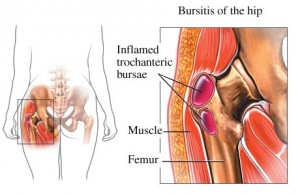What is Hip Bursitis?
Bursitis is caused due to swelling of a bursa, a small jelly-like sac that usually contains a small amount of fluid. Bursae are located all over the body, most importantly around the shoulder, elbow, hip, knee, and heel. They act as cushions between bones and the overlying soft tissues, and help reduce friction between the gliding muscles and the bone.
The greater trochanter is the bony point of the hip. It is an attachment point for muscles that move the hip joint. The trochanter has a fairly large bursa overlying it that sometimes becomes irritated, resulting in hip bursitis.
Hip Bursitis Symptoms
Symptoms include joint pain and tenderness. You may feel warmth around the affected area. The pain is often sharp in the initial days. It may be dull and achy after few days. You may experience it more when getting out of a bed or chair. You may also notice it when sitting for a long period of time and when sleeping on the affected side.
Acute bursitis usually flares over hours or days. Chronic bursitis can range from a few days to several weeks. It can go away and come back again. Acute bursitis can become chronic if it returns or if a hip injury occurs.
Over time, the bursa may become thick, which can worsen the swelling. This can lead to limited motion and weakened muscles in the area.
Diagnosis of Hip Bursitis
Doctors can often diagnose hip bursitis based on a medical history and physical exam. Testing, if needed, might include:
- Imaging tests.X-ray images can’t positively establish the diagnosis of bursitis, but they can help to exclude other causes of one’s discomfort. Ultrasound or MRI might be done if your bursitis can’t easily be diagnosed by a physical exam alone.
- Lab tests.Your doctor might order blood tests or an analysis of fluid from the inflamed bursa to pinpoint the reason of your joint inflammation and pain.
Treatment for Hip Bursitis
Treatment for bursitis usually involves resting the joint as much as possible. One can also use an ice pack on the area to reduce swelling. During this time, be sure to avoid any activity that can make the symptoms worse.
The doctor may suggest exercising the area once the pain decreases. This helps prevent muscle atrophy. Ask the doctor about physical exercises to help build strength in the area. Bursitis may affect one’s ability to function in a normal way. If so, one may need physical therapy to help move again. This is basically true if one has chronic bursitis.
If these treatments don’t help,one may need to have fluid taken out of the bursa or may need steroid shots to reduce swelling and pain. Steroid shots are usually very fruitful in treating bursitis. One may need another shot after a few months.
Surgery is rarely needed to treat bursitis. It is used only when all other treatments are not succesful. For people who do need surgery, it is a simple process. The doctor removes the bursa from the hip. The hip can function normally without the bursa. Normally, the surgery doesn’t require a long hospital stay. The recovery period is brief.
Consultation for Hip Bursitis in Singapore
We do provide treatment for hip bursitis so please feel free to contact us. We are conveniently located at Gleneagles Medical Centre, Central Part of Singapore. We provide same day appointment and Xray/MRI prior advanced arrangement.






